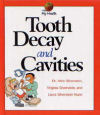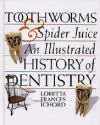Putting the Squeeze on Toothpaste Additional Information
You can learn more about toothpaste at en.wikipedia.org/wiki/Toothpaste(Wikipedia).
To find out more about toothpaste and brushing teeth, go to www.ada.org/public/topics/cleaning.asp (American Dental Association).
An article about research on toothpaste can be found at focus.aps.org/story/v6/st24(American Physical Society).
An article about physicist David Weitz and his research on everyday materials is available at www.hno.harvard.edu/gazette/2000/03.09/weitz.html (Harvard University).
Sohn, Emily. 2006. Spit power. Science News for Kids (Feb. 1). Available at http://www.sciencenewsforkids.org/2006/01/spit-power-2/.
______. 2003. The down side of keeping clean. Science News for Kids (April 2). Available at http://www.sciencenewsforkids.org/2003/06/the-down-side-of-keeping-clean-3/.
ScienceFairZone
Fluoride Treatments and Enamel Erosion
http://www.sciencenewsforkids.org/articles/20030820/ScienceFairZone.asp
LabZone
Bad Taste Genes
http://www.sciencenewsforkids.org/articles/20060215/LZActivity.asp
Books recommended by SearchIt!Science:
 |
Toothpaste: From Start to Finish— Tanya Lee Stone
Published by Blackbirch Press/Gale Group, 2001.
Did you ever wonder how toothpaste makes it into the tube? Take a tour of a factory where they mix all-natural ingredients to make toothpaste. Find out why this company adds chalk and seaweed to its toothpaste. Read about an important step in the manufacturing process—a taste test. And then, it’s time to learn how they get that toothpaste into the tubes! After the final check, the toothpaste is packed and ready to be shipped to a store near you. |
 |
Tooth Decay and Cavities — Alvin Silverstein, Virginia Silverstein, Laura Silverstein Nunn
Published by Franklin Watts/Scholastic, 1999.
How do animals that don’t have teeth eat their food? What are milk teeth? What’s in a tooth? What kinds of food sticks to your teeth? How do you clean your teeth properly? How do the parts of your body work together to keep you healthy? In this book you’ll find answers to questions such as these. You’ll also explore the science behind illnesses and injuries. Includes photos, illustrations, tables, sidebars, and activities. |
 |
Toothworms and Spider Juice: An Illustrated History of Dentistry— Loretta Frances Ichord
Published by Millbrook Press, 2000.
Imagine that it is hundreds, or even thousands, of years ago, and you’ve got a terrible toothache. What would you do? For one thing, you wouldn’t even know what caused your pain. People once had the idea that toothaches were caused by toothworms, which thrashed about inside one’s mouth to cause pain and agony. Then, without a dentist to turn to, you’d have to try some home cures, such as donkey’s milk and other animal and plant remedies. Learn about these things and other ancient dental practices in this book, which features two-color illustrations and black-and-white photographs and period drawings. Find out how teeth were extracted and drilled without modern implements and anesthesia, learn about ancient surgeons and “tooth drawers,” and read the story of Apollonia, patron saint of dentists. From ancient dentures up to modern X rays, this history of dentistry is sure to intrigue even the squeamish reader. |
Power Words
abrasion The process of wearing away or rubbing down by means of friction.
enamel The hard, white substance that covers the part of the tooth that sticks out from the gums.
plaque A film of mucus and bacteria on the surface of teeth.
Copyright © 2002, 2003 Houghton-Mifflin Company. All rights reserved. Used with permission.
